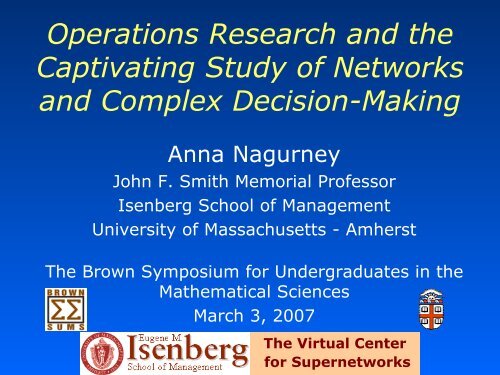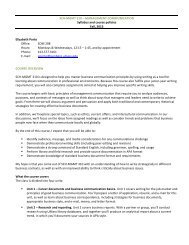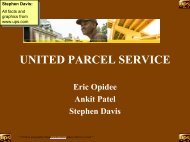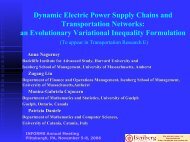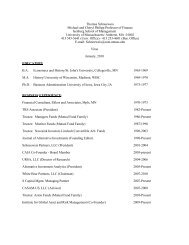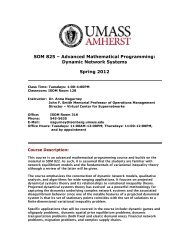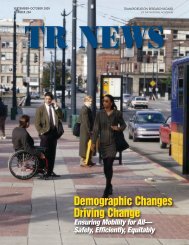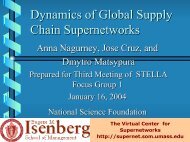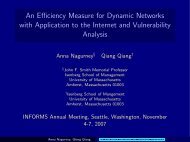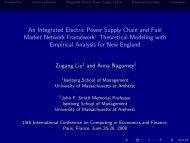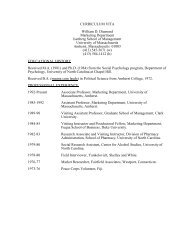Operations Research and the Captivating Study of Networks
Operations Research and the Captivating Study of Networks
Operations Research and the Captivating Study of Networks
You also want an ePaper? Increase the reach of your titles
YUMPU automatically turns print PDFs into web optimized ePapers that Google loves.
<strong>Operations</strong> <strong>Research</strong> <strong>and</strong> <strong>the</strong><br />
<strong>Captivating</strong> <strong>Study</strong> <strong>of</strong> <strong>Networks</strong><br />
<strong>and</strong> Complex Decision-Making<br />
Anna Nagurney<br />
John F. Smith Memorial Pr<strong>of</strong>essor<br />
Isenberg School <strong>of</strong> Management<br />
University <strong>of</strong> Massachusetts - Amherst<br />
The Brown Symposium for Undergraduates in <strong>the</strong><br />
Ma<strong>the</strong>matical Sciences<br />
March 3, 2007<br />
The Virtual Center<br />
for Supernetworks
Funding for this research has been provided by:<br />
National Science Foundation<br />
AT&T Foundation<br />
John F. Smith Memorial Fund -<br />
University <strong>of</strong> Massachusetts at<br />
Amherst
Outline <strong>of</strong> Presentation:<br />
• Background - <strong>Operations</strong> <strong>Research</strong><br />
• Brief History <strong>of</strong> <strong>the</strong> Science <strong>of</strong> <strong>Networks</strong><br />
• Interdisciplinary Impact <strong>of</strong> <strong>Networks</strong><br />
• The Transportation Network Equilibriumn Problem <strong>and</strong><br />
Methodological Tools<br />
• The Braess Paradox<br />
• Some Interesting Applications <strong>of</strong> Variational<br />
Inequalities<br />
• The Time-Dependent (Dem<strong>and</strong>-Varying) Braess<br />
Paradox <strong>and</strong> Evolutionary Variational Inequalities<br />
• A New Network Performance/Efficiency Measure with<br />
Applications to Critical Infrastructure <strong>Networks</strong>
What is <strong>Operations</strong> <strong>Research</strong> (OR)?<br />
<strong>Operations</strong> research is a scientific approach<br />
<strong>of</strong> using ma<strong>the</strong>matical models <strong>and</strong><br />
algorithms to aid in decision-making.<br />
It is usually used to analyze complex realworld<br />
systems <strong>and</strong> to improve or<br />
optimize performance.<br />
It is, by its nature, interdisciplinary.
We are in a New Era <strong>of</strong> Decision-<br />
Making Characterized by:<br />
• complex interactions among decision-makers in<br />
organizations;<br />
• alternative <strong>and</strong> at times conflicting criteria used in<br />
decision-making;<br />
• constraints on resources: natural, human, financial,<br />
time, etc.;<br />
• global reach <strong>of</strong> many decisions;<br />
• high impact <strong>of</strong> many decisions;<br />
• increasing risk <strong>and</strong> uncertainty, <strong>and</strong><br />
• <strong>the</strong> importance <strong>of</strong> dynamics <strong>and</strong> realizing a fast <strong>and</strong><br />
sound response to evolving events.
Network problems are <strong>the</strong>ir own class <strong>of</strong><br />
problems <strong>and</strong> <strong>the</strong>y come in various forms <strong>and</strong><br />
formulations, i.e., as optimization (linear or<br />
nonlinear) problems or as equilibrium<br />
problems <strong>and</strong> even dynamic network<br />
problems.<br />
Network problems will be <strong>the</strong> focus <strong>of</strong> this talk.
Subway Network<br />
Transportation,<br />
Communication,<br />
<strong>and</strong><br />
Energy <strong>Networks</strong><br />
Railroad Network<br />
Iridium Satellite<br />
Constellation Network<br />
Satellite <strong>and</strong> Undersea<br />
Cable <strong>Networks</strong><br />
Duke Energy Gas<br />
Pipeline Network
Components <strong>of</strong> Common Physical<br />
<strong>Networks</strong><br />
Network System Nodes Links Flows<br />
Transportation<br />
Intersections,<br />
Homes,<br />
Workplaces,<br />
Airports,<br />
Railyards<br />
Roads,<br />
Airline Routes,<br />
Railroad Track<br />
Automobiles,<br />
Trains, <strong>and</strong><br />
Planes,<br />
Manufacturing<br />
<strong>and</strong> logistics<br />
Communication<br />
Workstations,<br />
Distribution<br />
Points<br />
Computers,<br />
Satellites,<br />
Telephone<br />
Exchanges<br />
Processing,<br />
Shipment<br />
Fiber Optic<br />
Cables<br />
Radio Links<br />
Components,<br />
Finished Goods<br />
Voice,<br />
Data,<br />
Video<br />
Energy<br />
Pumping<br />
Stations,<br />
Plants<br />
Pipelines,<br />
Transmission<br />
Lines<br />
Water,<br />
Gas, Oil,<br />
Electricity
US Railroad Freight Flows
Internet Traffic Flows Over One 2<br />
Hour Period<br />
from Stephen Eick, Visual Insights
Electricity is Modernity
The scientific study <strong>of</strong> networks<br />
involves:<br />
•how to model such applications as<br />
ma<strong>the</strong>matical entities,<br />
•how to study <strong>the</strong> models<br />
qualitatively,<br />
• how to design algorithms to solve<br />
<strong>the</strong> resulting models.
The Basic Components <strong>of</strong> <strong>Networks</strong><br />
Nodes Links Flows<br />
1 2<br />
3<br />
4<br />
5<br />
6<br />
7 8 9<br />
10<br />
11<br />
12 13 14 15<br />
16<br />
17 18 19 20
Classic Examples <strong>of</strong> Network Problems<br />
The Shortest Path Problem<br />
The Maximum Flow Problem<br />
The Minimum Cost Flow Problem.
The Shortest Path Problem<br />
2<br />
2<br />
4<br />
4<br />
2<br />
1<br />
4<br />
1<br />
2<br />
3<br />
2<br />
6<br />
3<br />
3<br />
5<br />
What is <strong>the</strong> shortest path from 1 to 6?
Applications <strong>of</strong> <strong>the</strong> Shortest Path Problem<br />
Arise in transportation <strong>and</strong><br />
telecommunications.<br />
O<strong>the</strong>r applications include:<br />
• simple building evacuation models<br />
• DNA sequence alignment<br />
• assembly line balancing<br />
• compact book storage in libraries.
The Maximum Flow Problem<br />
10,<br />
1<br />
8<br />
s<br />
1<br />
t<br />
6<br />
2<br />
10<br />
Each link has a maximum capacity.<br />
How does one Maximize <strong>the</strong> flow from s to t,<br />
subject to <strong>the</strong> link capacities?
Applications <strong>of</strong> <strong>the</strong> Maximum Flow<br />
Problem<br />
• machine scheduling<br />
• network reliability testing<br />
• building evacuation
The Minimum Cost Flow Problem<br />
$4 ,10<br />
2<br />
$3 ,12<br />
1<br />
$6,6<br />
4<br />
$6 ,15<br />
3<br />
$2 ,13<br />
Each link has a linear cost <strong>and</strong> a maximum capacity.<br />
How does one Minimize Cost for a given flow from 1 to 4?
The Optimization Formulation<br />
Flow out <strong>of</strong> node i - Flow into node i = b(i)<br />
Minimize Σ i,j c ij x ij<br />
s.t. Σ j x ij - Σ j x ji = b(i) for each node i<br />
0 ˜ x ij ˜ u ij for all i,j<br />
Σ i b(i) = 0
Applications <strong>of</strong> <strong>the</strong><br />
Minimum Cost Flow Problem<br />
• warehousing <strong>and</strong> distribution<br />
• vehicle fleet planning<br />
• cash management<br />
• automatic chromosome classification<br />
• satellite scheduling
The study <strong>of</strong> <strong>the</strong> efficient operation on<br />
transportation networks dates to ancient<br />
Rome with a classical example being <strong>the</strong><br />
publicly provided Roman road network <strong>and</strong><br />
<strong>the</strong> time <strong>of</strong> day chariot policy, whereby<br />
chariots were banned from <strong>the</strong> ancient city <strong>of</strong><br />
Rome at particular times <strong>of</strong> day.
Brief History <strong>of</strong> <strong>the</strong><br />
Science <strong>of</strong> <strong>Networks</strong><br />
1736 - Euler - <strong>the</strong> earliest paper on graph <strong>the</strong>ory -<br />
Konigsberg bridges problem.<br />
1758 - Quesnay in his Tableau Economique<br />
introduced a graph to depict <strong>the</strong> circular flow <strong>of</strong><br />
financial funds in an economy.
1845 - Kirchh<strong>of</strong>f wrote Laws <strong>of</strong> Closed Electric Circuits.<br />
1781 - Monge, who had worked under Napoleon<br />
Bonaparte, publishes what is probably <strong>the</strong> first paper<br />
on transportation in minimizing cost.<br />
1838 - Cournot states that a competitive price is<br />
determined by <strong>the</strong> intersection <strong>of</strong> supply <strong>and</strong> dem<strong>and</strong><br />
curves in <strong>the</strong> context <strong>of</strong> spatially separate markets in<br />
which transportation costs are included.<br />
1841 - Kohl considered a two node, two route<br />
transportation network problem.
1920 - Pigou studied a transportation network system <strong>of</strong> two<br />
routes <strong>and</strong> noted that <strong>the</strong> decision-making behavior <strong>of</strong> <strong>the</strong><br />
users on <strong>the</strong> network would result in different flow patterns.<br />
1936 - Konig published <strong>the</strong> first book on graph <strong>the</strong>ory.<br />
1939, 1941, 1947 - Kantorovich, Hitchcock, <strong>and</strong> Koopmans<br />
considered <strong>the</strong> network flow problem associated with <strong>the</strong><br />
classical minimum cost transportation problem <strong>and</strong> provided<br />
insights into <strong>the</strong> special network structure <strong>of</strong> <strong>the</strong>se problems,<br />
which yielded special-purpose algorithms.<br />
1948, 1951 - Dantzig published <strong>the</strong> simplex method for linear<br />
programming <strong>and</strong> adapted it for <strong>the</strong> classical transportation<br />
problem.
1951 - Enke showed that spatial price equilibrium<br />
problems can be solved using electronic circuits<br />
1952 - Copel<strong>and</strong> in his book asked, Does money flow<br />
like water or electricity?<br />
1952 - Samuelson gave a rigorous ma<strong>the</strong>matical<br />
formulation <strong>of</strong> spatial price equilibrium <strong>and</strong><br />
emphasized <strong>the</strong> network structure.
1956 - Beckmann, McGuire, <strong>and</strong> Winsten in <strong>the</strong>ir<br />
book, Studies in <strong>the</strong> Economics <strong>of</strong> Transportation,<br />
provided a rigorous treatment <strong>of</strong> congested urban<br />
transportation systems under different behavioral<br />
mechanisms due to Wardrop (1952).<br />
1962 - Ford <strong>and</strong> Fulkerson publish Flows in<br />
<strong>Networks</strong>.<br />
1969 - Dafermos <strong>and</strong> Sparrow coined <strong>the</strong> terms useroptimization<br />
<strong>and</strong> system-optimization <strong>and</strong> develop<br />
algorithms for <strong>the</strong> computation <strong>of</strong> solutions that<br />
exploit <strong>the</strong> network structure <strong>of</strong> transportation<br />
problems.
<strong>Networks</strong> in Different Disciplines<br />
economics<br />
<strong>and</strong> finance<br />
<strong>Operations</strong> research/<br />
management science<br />
Ma<strong>the</strong>matics<br />
public<br />
policy<br />
<strong>Networks</strong><br />
biology<br />
Engineering/<br />
physics<br />
Computer<br />
science
Interdisciplinary Impact <strong>of</strong> <strong>Networks</strong><br />
Economics<br />
Interregional Trade<br />
General Equilibrium<br />
Industrial Organization<br />
Portfolio Optimization<br />
Flow <strong>of</strong> Funds<br />
Accounting<br />
Sociology<br />
Social <strong>Networks</strong><br />
Organizational<br />
Theory<br />
<strong>Networks</strong><br />
Computer Science<br />
Routing Algorithms<br />
Energy<br />
Engineering<br />
Manufacturing<br />
Telecommunications<br />
Transportation<br />
Biology<br />
DNA Sequencing<br />
Targeted Cancer<br />
Therapy
Characteristics <strong>of</strong> <strong>Networks</strong> Today<br />
• large-scale nature <strong>and</strong> complexity <strong>of</strong> network<br />
topology;<br />
• congestion;<br />
• alternative behavior <strong>of</strong> users <strong>of</strong> <strong>the</strong> network, which<br />
may lead to paradoxical phenomena;<br />
• <strong>the</strong> interactions among networks <strong>the</strong>mselves such as<br />
in transportation versus telecommunications;<br />
• policies surrounding networks today may have a<br />
major impact not only economically but also socially,<br />
politically, <strong>and</strong> security-wise.
There are two fundamental principles <strong>of</strong> travel behavior,<br />
due to Wardrop (1952), which we refer to as useroptimization<br />
(or network equilibrium) or systemoptimization.<br />
These terms were coined by Dafermos<br />
<strong>and</strong> Sparrow (1969); see also Beckmann, McGuire,<br />
<strong>and</strong> Winsten (1956).<br />
In a user-optimized (network equilibrium) problem,<br />
each user <strong>of</strong> a network system seeks to determine<br />
his/her cost-minimizing route <strong>of</strong> travel between an<br />
origin/destination pair, until an equilibrium is reached,<br />
in which no user can decrease his/her cost <strong>of</strong> travel<br />
by unilateral action.<br />
In a system-optimized network problem, users are<br />
allocated among <strong>the</strong> routes so as to minimize <strong>the</strong><br />
total cost in <strong>the</strong> system. Both classes <strong>of</strong> problems,<br />
under certain imposed assumptions, possess<br />
optimization formulations.
The Brown Connection<br />
Amazingly, Brown has been home to such<br />
luminaries in transportation networks as:<br />
• William Prager, who in 1954 published a paper,<br />
which discussed <strong>the</strong> importance <strong>of</strong> extended type<br />
<strong>of</strong> traffic network models in which <strong>the</strong> cost on a<br />
link could depend not only on its own flow<br />
• Gordon Newell<br />
• Martin Beckmann<br />
• Stella Dafermos
INFORMS Honoring <strong>the</strong> 50th<br />
Anniversary <strong>of</strong> <strong>the</strong> Publication <strong>of</strong><br />
Studies in <strong>the</strong> Economics <strong>of</strong><br />
Transportation<br />
The<br />
Transportation<br />
Social -<br />
Knowledge<br />
Network<br />
On <strong>the</strong> Beach in<br />
Mallacoota, Austrailia<br />
Pr<strong>of</strong>essors Beckmann <strong>and</strong><br />
Dafermos at Anna Nagurney’s<br />
Post-Ph.D. Defense Party in<br />
Barus Holley<br />
Pr<strong>of</strong>essor Beckmann with<br />
Pr<strong>of</strong>essor Michael Florian<br />
<strong>of</strong> Montreal<br />
Pr<strong>of</strong>essors Beckman<br />
<strong>and</strong> McGuire
Transportation Network Equilibrium
The Braess (1968) Paradox<br />
Assume a network with a single<br />
O/D pair (1,4). There are 2<br />
1<br />
paths available to travelers:<br />
a b<br />
p 1 =(a,c) <strong>and</strong> p 2 =(b,d).<br />
For a travel dem<strong>and</strong> <strong>of</strong> 6, <strong>the</strong><br />
2<br />
3<br />
equilibrium path flows are x<br />
*<br />
p1<br />
= x<br />
*<br />
p2 = 3 <strong>and</strong><br />
c d<br />
The equilibrium path travel cost<br />
4<br />
is<br />
C p1 = C p2 = 83.<br />
c a (f a )=10 f a c b (f b ) = f b +50<br />
c c (f c ) = f c +50 c d (f d ) = 10 f d
Adding a Link<br />
Increases Travel Cost for All!<br />
Adding a new link creates a new path<br />
p 3 =(a,e,d).<br />
The original flow distribution pattern is<br />
no longer an equilibrium pattern, since<br />
at this level <strong>of</strong> flow <strong>the</strong> cost on path p 3 ,<br />
C p3 =70.<br />
The new equilibrium flow pattern<br />
network is<br />
x<br />
*<br />
p1 = x<br />
*<br />
p2 = x p3* =2.<br />
The equilibrium path travel costs: C = p1<br />
C = C p2 p 3<br />
= 92.<br />
2<br />
a<br />
c<br />
1<br />
e<br />
4<br />
b<br />
d<br />
c e (f e ) = f e + 10<br />
3
The 1968 Braess article has been translated from<br />
German to English <strong>and</strong> appears as<br />
On a Paradox <strong>of</strong> Traffic Planning<br />
by Braess, Nagurney, Wakolbinger<br />
in <strong>the</strong> November 2005 issue <strong>of</strong> Transportation Science.
If no such symmetry assumption holds for<br />
<strong>the</strong> user link costs functions, <strong>the</strong>n <strong>the</strong><br />
equilibrium conditions can no longer be<br />
reformulated as an associated optimization<br />
problem <strong>and</strong> <strong>the</strong> equilibrium conditions are<br />
formulated <strong>and</strong> solved as a variational<br />
inequality problem!<br />
Smith (1979), Dafermos (1980)
VI Formulation <strong>of</strong><br />
Transportation Network Equilibrium<br />
(Dafermos (1980), Smith (1979))
A Geometric Interpretation<br />
<strong>of</strong> a Variational Inequality
The variational inequality problem, contains, as<br />
special cases, such classical problems as:<br />
• systems <strong>of</strong> equations<br />
• optimization problems<br />
• complementarity problems<br />
<strong>and</strong> is also closely related to fixed point<br />
problems.<br />
Hence, it is a unifying ma<strong>the</strong>matical formulation<br />
for a variety <strong>of</strong> ma<strong>the</strong>matical programming<br />
problems.
In particular, variational inequalities have been<br />
used to formulate such equilibrium problems<br />
as:<br />
• transportation network equilibrium problems<br />
• spatial price equilibrium problems<br />
• oligopolistic market equilibrium problems<br />
operating under Nash equilibrium<br />
• migration equilibrium problems<br />
• a variety <strong>of</strong> financial equilibrium problems.<br />
Moreover, all such problems have network<br />
structure, which can be fur<strong>the</strong>r exploited for<br />
computational purposes.
In addition, with <strong>the</strong> advent <strong>of</strong> <strong>the</strong> Internet, <strong>the</strong>re<br />
are numerous new models <strong>and</strong> applications, in<br />
which variational inequalities have become a very<br />
powerful tool for formulation, qualitative analysis,<br />
<strong>and</strong> computations. Some <strong>of</strong> <strong>the</strong>se application, we<br />
will be discussing in this presentation.<br />
Indeed, <strong>the</strong> concept <strong>of</strong> network equilibrium is as<br />
relevant to <strong>the</strong> Internet as it is to transportation!
Some Interesting Applications<br />
• Telecommuting/Commuting Decision-Making<br />
• Teleshopping/Shopping Decision-Making<br />
• Supply Chain <strong>Networks</strong> with Electronic Commerce<br />
• Financial <strong>Networks</strong> with Electronic Transactions<br />
• Reverse Supply Chains with E-Cycling<br />
• Knowledge <strong>Networks</strong><br />
• Energy <strong>Networks</strong>/Power Grids<br />
• Social <strong>Networks</strong> integrated with Economic<br />
<strong>Networks</strong>
The Equivalence <strong>of</strong><br />
Supply Chain <strong>Networks</strong> <strong>and</strong><br />
Transportation <strong>Networks</strong><br />
Nagurney, Transportation <strong>Research</strong> E (2006)
Nagurney, Ke, Cruz, Hancock, Southworth, Environment <strong>and</strong> Planning B (2002)
The fifth chapter <strong>of</strong> Beckmann, McGuire, <strong>and</strong><br />
Winsten’s book, Studies in <strong>the</strong><br />
Economics <strong>of</strong> Transportation (1956)<br />
describes some unsolved problems<br />
including a single commodity network<br />
equilibrium problem that <strong>the</strong> authors imply<br />
could be generalized to capture electric<br />
power networks.<br />
Specifically, <strong>the</strong>y ask whe<strong>the</strong>r electric power<br />
generation <strong>and</strong> distribution networks can be<br />
reformulated as transportation network<br />
equilibrium problems.
The Electric Power Supply Chain<br />
Network<br />
Nagurney <strong>and</strong> Matsypura, Proceedings <strong>of</strong> <strong>the</strong> CCCT (2004)
Nagurney et al, to appear in Transportation <strong>Research</strong> E<br />
The Transportation Network<br />
Equilibrium Reformulation <strong>of</strong> Electric<br />
Power Supply Chain <strong>Networks</strong><br />
Electric Power Supply Transportation<br />
Chain Network Network
In 1952, Copel<strong>and</strong> wondered whe<strong>the</strong>r<br />
money flows like water or electricity.
The Transportation Network<br />
Equilibrium Reformulation <strong>of</strong> <strong>the</strong><br />
Financial Network Equilibrium Model<br />
with Intermediation<br />
Liu <strong>and</strong> Nagurney, Computational Management Science (2006)
We have shown that money as well as<br />
electricity flow like transportation <strong>and</strong> have<br />
answered questions posed fifty years ago by<br />
Copel<strong>and</strong> <strong>and</strong> Beckmann, McGuire, <strong>and</strong><br />
Winsten!
We are using evolutionary variational inequalities to<br />
model dynamic networks with:<br />
• dynamic (time-dependent) supplies <strong>and</strong> dem<strong>and</strong>s<br />
• dynamic (time-dependent) capacities<br />
• structural changes in <strong>the</strong> networks <strong>the</strong>mselves.<br />
Such issues are important for robustness, resiliency,<br />
<strong>and</strong> reliability <strong>of</strong> networks (including supply chains<br />
<strong>and</strong> <strong>the</strong> Internet).
Evolutionary Variational Inequalities<br />
Evolutionary variational inequalities, which are infinite<br />
dimensional, were originally introduced by Lions <strong>and</strong><br />
Stampacchia (1967) <strong>and</strong> by Brezis (1967) in order to study<br />
problems arising principally from mechanics. They provided a<br />
<strong>the</strong>ory for <strong>the</strong> existence <strong>and</strong> uniqueness <strong>of</strong> <strong>the</strong> solution <strong>of</strong> such<br />
problems.<br />
Steinbach (1998) studied an obstacle problem with a memory<br />
term as a variational inequality problem <strong>and</strong> established<br />
existence <strong>and</strong> uniqueness results under suitable assumptions<br />
on <strong>the</strong> time-dependent conductivity.<br />
Daniele, Maugeri, <strong>and</strong> Oettli (1998, 1999), motivated by dynamic<br />
traffic network problems, introduced evolutionary (timedependent)<br />
variational inequalities to this application domain<br />
<strong>and</strong> to several o<strong>the</strong>rs. See also Ran <strong>and</strong> Boyce(1996).
Bellagio <strong>Research</strong><br />
Team Residency<br />
March 2004
Recall <strong>the</strong> Braess Network<br />
where we add <strong>the</strong> link e.<br />
2<br />
c<br />
a<br />
1<br />
e<br />
4<br />
b<br />
d<br />
3
The Solution <strong>of</strong> an Evolutionary<br />
(Time-Dependent) Variational Inequality<br />
for <strong>the</strong> Braess Network with Added Link (Path)<br />
Equilibrium Path Flow<br />
10<br />
5<br />
0<br />
I II III<br />
3.64 8.88<br />
0 10 20<br />
Dem<strong>and</strong>(t) = t<br />
Braess Network with<br />
Time-Dependent<br />
Dem<strong>and</strong>s<br />
Paths 1 <strong>and</strong> 2<br />
Path 3
In Dem<strong>and</strong> Regime I, only <strong>the</strong> new path is used.<br />
In Dem<strong>and</strong> Regime II, <strong>the</strong> Addition <strong>of</strong> a New Link (Path) Makes Everyone<br />
Worse Off!<br />
In Dem<strong>and</strong> Regime III, only <strong>the</strong> original paths are used.<br />
Cost <strong>of</strong> Used Paths<br />
160<br />
120<br />
80<br />
40<br />
0<br />
I II III<br />
0 5 10 15 20<br />
Network 1<br />
Dem<strong>and</strong><br />
Network 2<br />
Network 1 is <strong>the</strong> Original Braess Network - Network 2 has <strong>the</strong> added link.
The new link is NEVER used after a<br />
certain dem<strong>and</strong> is reached even if <strong>the</strong><br />
dem<strong>and</strong> approaches infinity.<br />
Hence, in general, except for a limited<br />
range <strong>of</strong> dem<strong>and</strong>, building <strong>the</strong> new link<br />
is a complete waste!
Recent disasters have demonstrated <strong>the</strong><br />
importance as well as <strong>the</strong> vulnerability <strong>of</strong><br />
network systems.<br />
For example:<br />
– Hurricane Katrina, August 23, 2005<br />
– The biggest blackout in North America,<br />
August 14, 2003<br />
– 9/11 Terrorist Attacks, September 11, 2001
The Nagurney <strong>and</strong> Qiang<br />
Network Efficiency Measure<br />
Nagurney <strong>and</strong> Qiang (2006) proposed a network<br />
efficiency measure which captures dem<strong>and</strong>, flow,<br />
<strong>and</strong> cost information under network equilibrium. It<br />
is defined as follows:
Importance <strong>of</strong> a Network Component
The Approach to <strong>Study</strong> <strong>the</strong><br />
Importance <strong>of</strong> Network Components<br />
The elimination <strong>of</strong> a link is treated in <strong>the</strong> Nagurney <strong>and</strong><br />
Qiang network efficiency measure by removing that<br />
link while <strong>the</strong> removal <strong>of</strong> a node is managed by<br />
removing <strong>the</strong> links entering <strong>and</strong> exiting that node.<br />
In <strong>the</strong> case that <strong>the</strong> removal results in no path<br />
connecting an O/D pair, we simply assign <strong>the</strong><br />
dem<strong>and</strong> for that O/D pair to an abstract path with a<br />
cost <strong>of</strong> infinity. Hence, our measure is well-defined<br />
even in <strong>the</strong> case <strong>of</strong> disconnected networks.
Example 1<br />
1<br />
Assume a network with two O/D pairs:<br />
w 1 =(1,2) <strong>and</strong> w 2 =(1,3) with dem<strong>and</strong>s:<br />
d w1 =100 <strong>and</strong> d w2 =20.<br />
C =C =20. p 1 p2<br />
The paths are:<br />
for w 1 , p 1 =a; for w 2 , p 2 =b.<br />
The equilibrium path flows are:<br />
a b<br />
x p1* = 100, x p2* =20.<br />
c a (f a )=0.01f a +19<br />
c b (f b )=0.05f b +19<br />
The equilibrium path travel costs are:<br />
2 3
Importance <strong>and</strong> Ranking<br />
Link<br />
<strong>of</strong> Links <strong>and</strong> Nodes<br />
Importance Value<br />
from Our Measure<br />
Importance Ranking<br />
from Our Measure<br />
a 0.8333 1<br />
b 0.1667 2<br />
Node<br />
Importance Value<br />
from Our Measure<br />
Importance Ranking<br />
from Our Measure<br />
1 1 1<br />
2 0.8333 2<br />
3 0.1667 3
Example 2<br />
The network is given by:
Link Cost Functions
Importance <strong>and</strong> Ranking <strong>of</strong> Links
Example 2 Link Importance Rankings<br />
1<br />
0.9<br />
0.8<br />
Importance Values<br />
0.7<br />
0.6<br />
0.5<br />
0.4<br />
0.3<br />
0.2<br />
0.1<br />
0<br />
2726 1 2 24 3 4 23 5 22 6 7 211020 8 25 9 19182812161113141517<br />
Link
The Advantages <strong>of</strong> <strong>the</strong> Nagurney <strong>and</strong><br />
Qiang Network Efficiency Measure<br />
• The measure captures dem<strong>and</strong>s, flows, costs, <strong>and</strong><br />
behavior <strong>of</strong> users, in addition to network topology;<br />
• The resulting importance definition <strong>of</strong> network<br />
components is applicable <strong>and</strong> well-defined even in<br />
<strong>the</strong> case <strong>of</strong> disconnected networks;<br />
• It can be used to identify <strong>the</strong> importance (<strong>and</strong><br />
ranking) <strong>of</strong> ei<strong>the</strong>r nodes, or links, or both; <strong>and</strong><br />
• It can be applied to assess <strong>the</strong><br />
efficiency/performance <strong>of</strong> a wide range <strong>of</strong> network<br />
systems.
Thank you!<br />
For more information, see<br />
http://supernet.som.umass.edu<br />
The Virtual Center<br />
for Supernetworks


